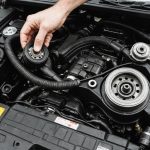Safety Precautions for Changing the Serpentine Belt
In DIY car repair, especially involving tasks like replacing the serpentine belt, safety must be a priority. Start by wearing protective gear such as safety goggles and gloves to guard against debris or unexpected spills. Protecting yourself is crucial in maintaining vehicle maintenance safety.
Before diving into the repair, ensure the vehicle is securely lifted and supported. Use a hydraulic jack to lift the vehicle and a set of jack stands to hold it in place. Never trust a jack alone, as it is prone to failure, risking severe injury or damage. Utilizing jack stands ensures the car stays stable, enabling you to work underneath safely.
Also to see : Essential Safety Tips for Performing an Electrical System Inspection on Hybrid Vehicles
Identifying potential hazards in advance helps prevent accidents. Check for sharp edges on engine components that might cause cuts or abrasions. Remove any flammable materials or liquids around the workspace to avoid fires. Ensure all tools are functioning correctly, as faulty equipment can pose a safety risk.
These safety measures play an integral role in an effective and secure serpentine belt safety procedure, providing peace of mind while performing your task efficiently. Remember, taking precautions is a tangible investment in personal and automobile well-being.
In the same genre : Top Techniques for Assessing Vehicle Frame Integrity Post-Accident: A Comprehensive Guide
Tools and Materials Needed
To successfully change a serpentine belt, having the right serpentine belt tools and materials is crucial for a smooth DIY car maintenance process. Automotive tools you need include a ratchet wrench, socket set, and belt tensioner tool. These tools are essential for loosening the tensioner and removing the old belt. Additionally, pliers may be helpful for manipulating tight spaces and securing the belt in place.
In terms of materials, a replacement serpentine belt is obviously at the top of the list. Ensure you purchase the correct size for your vehicle model. Lubrication sprays may also be useful, especially if there are squeaks or noises to address once the new belt is installed.
When it comes to tool brands, it’s advisable to invest in trusted names known for durability and reliability, like Craftsman or Snap-on. These brands provide quality tools that can assist in more than just changing a serpentine belt, making them a wise investment for any car enthusiast. Opt for tools specifically designed for automotive tasks, as they simplify the work, reduce the margin of error, and help avoid potential damage to your vehicle during DIY car maintenance.
Step-by-Step Guide to Remove the Old Belt
Replacing a serpentine belt is a vital part of automotive maintenance. This guide outlines crucial steps for a successful serpentine belt removal.
Preparing the Vehicle
Begin by ensuring the vehicle is safely parked on a level surface. Turn off the engine and disconnect the battery to prevent accidental starts. Use a jack to elevate the front end, ensuring stability with jack stands. This setup allows unobstructed access to the engine bay, a necessity when you remove serpentine belt.
Locating the Serpentine Belt Routing Diagram
Before diving into the removal, locate the serpentine belt routing diagram. This diagram is often found on a sticker under the hood or in the vehicle’s manual. It shows the specific route the belt takes around various pulleys. Referencing this is crucial for ensuring the new belt mirrors the old path precisely.
Using the Tensioner Tool
Employ a tensioner tool to release tension on the belt. Locate the tensioner pulley and apply the tool, turning it to loosen the belt. This step is critical; improper technique may harm the pulley system.
By detailing each phase, these automotive repair steps ensure effective serpentine belt removal and replacement, ensuring your vehicle runs smoothly.
Inspecting Components Before Installation
Before embarking on an automotive part check, it’s crucial to focus on thorough serpentine belt inspection. This process ensures the longevity and efficient functioning of your vehicle. To begin with, check pulleys and tensioners for any signs of wear and tear. They should move freely without any obstruction. If they seem misaligned or make unusual noises, replacement might be necessary to prevent further issues.
Furthermore, inspect for signs of damage in components associated with the serpentine belt, such as cracks or fraying edges. These indicators suggest that the belt is nearing the end of its life and warrants a replacement. Additionally, the presence of oil or coolant leaks can degrade belt material, hence needing prompt attention.
Equally important is the cleaning of the area before installation of any new components. This not only ensures proper adhesion but also helps in spotting any underlying issues that may not be visible at first glance. A clean environment aids in an efficient vehicle maintenance routine, safeguarding the lifespan of newly installed parts. With these steps, a seamless and long-lasting installation can be achieved, maintaining your vehicle’s optimal performance.
Installing the New Serpentine Belt
Before beginning any automotive repair installation, it’s crucial to have a clear understanding of the installation process. This guide will navigate through the key steps involved in a seamless serpentine belt installation.
Correct Belt Path Installation
Correctly routing the new serpentine belt is essential for optimal performance. An incorrect path can lead to improper tension and potential failure. Refer to your vehicle’s service manual for the precise belt path. Ensure that the belt fits snugly across all pulleys and that no kinks obstruct its path. Mistakes here can lead to significant mechanical issues.
Applying Tension to the New Belt
Proper tension is vital to prevent slippage. Use a belt tensioner or adjust the tension manually, if applicable to your model. The key is to apply enough tension to keep the belt firm but not overtightened. Excessive tension can damage components, while insufficient tension can cause slipping, reducing the belt’s lifespan.
Double-Checking Alignment
Double-check the alignment by inspecting how the belt sits on pulleys. Ensure the belt is centred and not leaning to one side. Misalignment can lead to premature wear. Start the engine momentarily and observe, ensuring there’s no wobble or noise. Regular inspections can mitigate future automotive mishaps.
Post-Installation Checks
Ensuring that your recent serpentine belt replacement is successful requires a few essential vehicle checks. Once the installation is complete, a checklist for final inspections is crucial for maintaining overall vehicle health.
Begin by starting the engine and observing the operation of the serpentine belt. This step is critical as it offers a firsthand look at how well the belt integrates with the rest of the engine components. Watch for smooth and consistent movement, as any deviation can indicate improper installation. Listen attentively for unusual sounds, such as squeaking or squealing, which often signal potential problems.
During these automotive troubleshooting sessions, it’s important to keep an eye out for common issues. Misalignment, excessive tension, or looseness can be red flags that need addressing. If the belt seems misaligned, consider readjusting it to ensure that it’s tracking correctly on the pulleys.
Additionally, take note of any vibrations or uncharacteristic noises appearing as you rev the engine. These can highlight further adjustments needed within the system. By following a thorough serpentine belt maintenance guide, you can effectively mitigate future failures, keeping your vehicle in optimal condition.
Troubleshooting Common Issues
Learning how to address serpentine belt issues can empower you to tackle automotive problems independently. Understanding the signs of wear and tear, and how to maintain your serpentine belt will keep your vehicle running smoothly.
Identifying Slippage
One common issue is slippage, which often occurs when the serpentine belt becomes loose. Detecting slippage involves observing the belt during operation for any delays or stuttering movements. Signs of slippage can include reduced engine power or flickering dashboard lights, indicating a compromised belt grip. Tightening the belt or replacing it with a correctly sized one can often resolve this.
Unusual Noises and Their Causes
Unusual noises like squealing or chirping frequently imply problems with the serpentine belt. These sounds can result from misalignment, wear, or debris caught in the pulleys. Regular inspection of the belt and its components is crucial. Worn belts may need to be replaced to eliminate these unpleasant noises.
Monitoring Performance Over Time
Keeping track of the serpentine belt‘s performance is vital. Regular visual inspections for cracks, fraying, or glazing can indicate when it’s time for maintenance or replacement. Adopting these DIY car repair tips will not only extend the belt’s longevity but also enhance your overall automotive troubleshooting skills.











